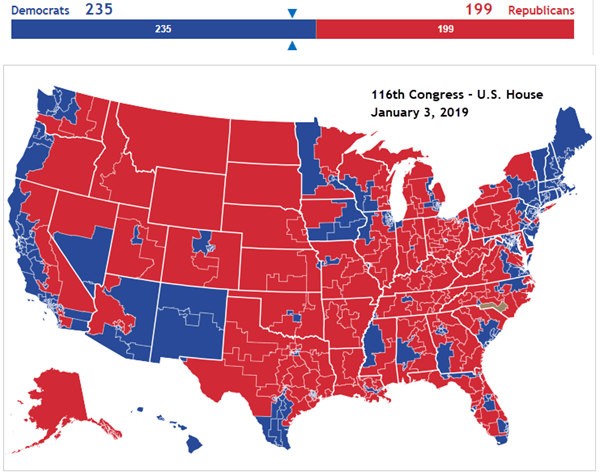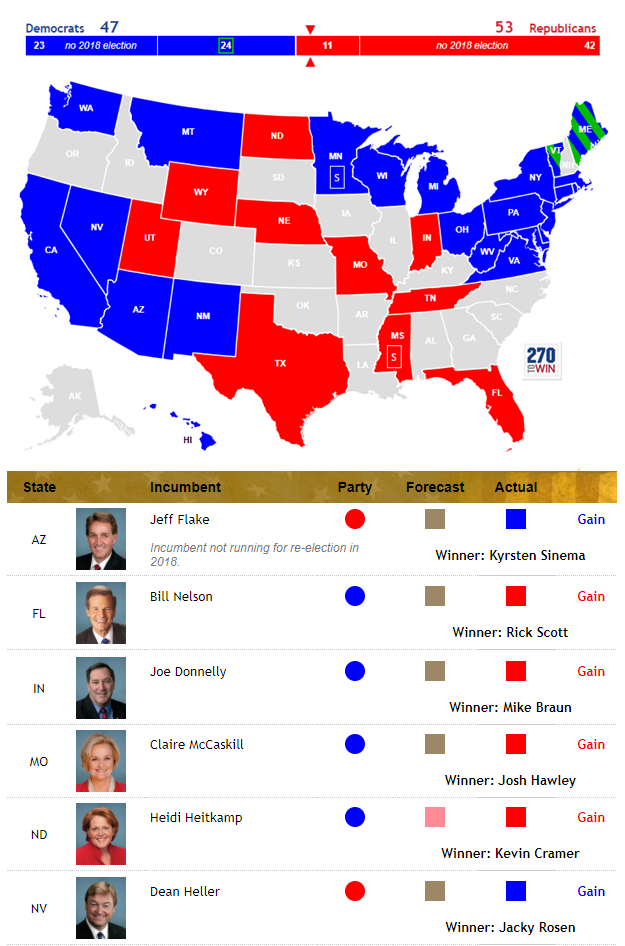The U.S. Elections Project has established that a majority (50.3%) of Americans eligible to vote participated in the 2018 general election. (The President ensured that both supporters and opponents were heavily motivated to vote.) And, with the Democrats winning 53.4% of the popular vote and 54% of the seats in the U.S. House of Representatives to the Republicans’ 44.8% of the vote (an 8.6% margin), the Democrats have the bragging rights that Americans clearly expressed the policy direction for which they wish the country to move forward.

Of course, it’s never that black and white/simple. Yet, the gist of the message is clear.
This was an election that does not bear over-thinking. Political strategists are warranted in searching for every nuance and understanding every vote as they build their next campaigns. For the rest of us, here are the other major takeaways:
1. It is to the benefit of the Democrats that they do not control the U.S. Senate. It lessens the pressure to take policy positions that may alienate swing voters and which have low likelihood of becoming law. It allows the party to focus on issues that are most practical in a divided nation and which emphasize its position as the more mature political party.

2. As those who study elections would point out, there are enough voters who sympathize with both major parties or vote based on specific issues that these voters can flip control of the House as they switch allegiance depending on the political environment. Will the almost 10-point margin of those who support the Democratic vision/balance to President Trump be there in the 2020 presidential election? Or will circumstances influence a shift in some manner back towards the Republicans? Essentially, despite the extraordinary political polarization today, it is not enough to predetermine national elections for the Democrats…for now.

3. Each national election in the near future will find the Democrats in a stronger position as forecast demographic changes take hold, the Census is conducted, and new political districts are drawn.
a. For example, the federal government’s National Center for Educational Statistics has projected that in two years, about half of the 14 – 17 year-olds will be ethnic minorities and that the share will continue to grow. Only 22 percent of ethnic minorities voted Republican this past election. Assuming the Democratic Party will be more in touch with ethnic minorities and the negative and diminishing view of the GOP among young minorities, this demographic development will continue to boost Democratic political fortunes.
b. Detractors will point to the 2016 presidential election and decry that “demographics are destiny.” I will posit that those touting demographic change have for years over-hyped the phenomenon as well as jumped the gun. Nevertheless, I believe we have finally reached the point where demographic change can help support a steady Democratic edge in national elections, and that edge will become more stable and stronger in the years to come. The just-completed election shows this through growing numbers and shares of minority, female, and young voters.

c. Population growth somewhat minimizes gerrymandering that favor Republicans as urban/suburban populations will diminish rural influence when the larger growth is factored into the drawing of new districts.
4. The Republicans are in a Catch-22 as they must please an increasingly obstinate and demanding base.
a. Yes, the Democrats have a similar problem with their progressive wing. Yet, it must be noted that Democratic voters have the same overall goals and concerns. Democrats are at least moving in the same direction and therefore have more flexibility to maneuver in uniting their voters.
b. That cannot be said for the economic/mainstream, populist, and evangelical wings of the GOP. They have accepted their alliance of convenience and even support some of their partners’ defining policy positions. Yet, as those positions move further from the mainstream, some GOP target voters become uneasy and have even been driven to the Democratic fold.
c. Republicans have made some uncertain policy promises to their base supporters and some of those supporters have demanded to collect or threatened withdraw their support, if not from political life altogether. In some of these cases, it is unlikely that those promises can be kept as the general public and practicality are leagues away.
d. The GOP strategy appears in part to be spin and misinformation to hold their base together. It is a strategy of holding onto power for as long as is possible and delaying the inevitable. Some of the base may eventually catch on. Others will pass on, potentially leaving a void less likely to be filled by new American voters. (I have joked that one of the best investments that the Republican Party can make is in nursing homes.)

Contemporary politics can be seen as divided between angry, resentful, and retiring Republicans and Democrats seeking a unified, substantive vision for a long-lasting winning coalition.
![]()
In the end, nothing is guaranteed in each election. Nevertheless, as the aforementioned dynamics continue on their current trajectory, there will continue to be the movement of voters towards the more cosmopolitan, classical liberal, and educated viewpoint of today’s Democrats versus the increasingly populist, nostalgic, and authoritarian one of the Republicans. The individual qualities of candidates will matter less while the party brand will matter more. This past election has significant examples, such as Congressmen Will Hurd and Carlos Curbelo, of high-quality incumbent Republicans who stood up to the President for their constituents’ values and still suffering substantial abandonment by voters.
It can be a slow process to dominance but the Democrats have the wind at their backs nationally and in many key areas.